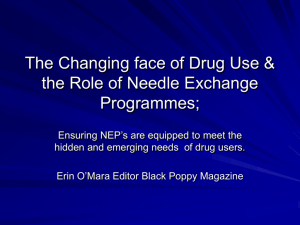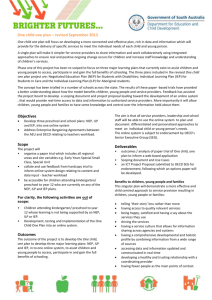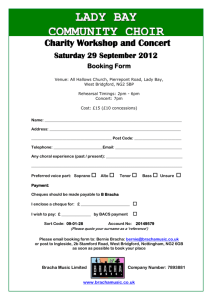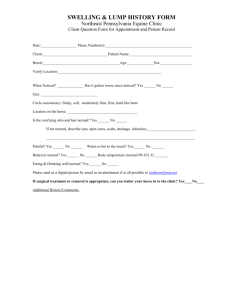Heat Stress Illnesses Cont'd
advertisement
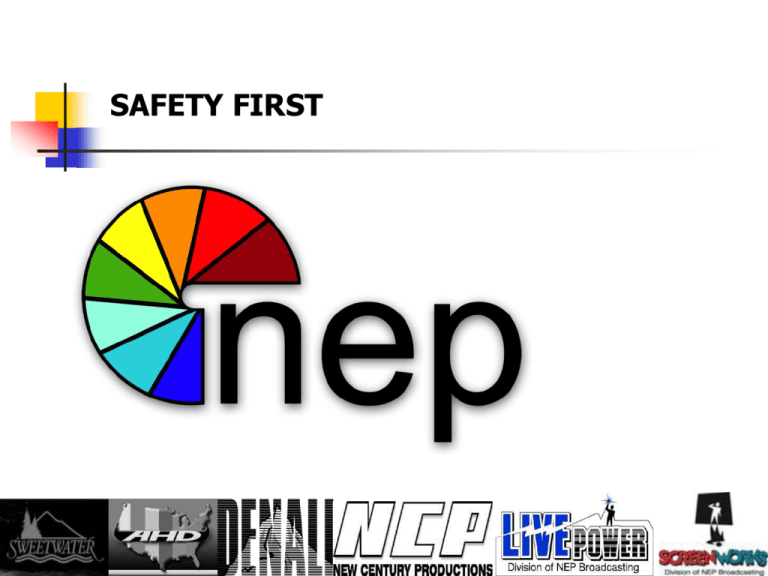
SAFETY FIRST NEP Safety It is the intention of NEP Broadcasting to initiate and maintain complete accident prevention and safety training programs and ensure a safe work environment for staff, clients, vendors, etc. Each and every employee working for NEP are responsible for the safety and health of those persons in their charge, coworkers, and others that may be on-site or in any NEP facility. By accepting mutual responsibility to participate in all safety practices, we will all contribute to the well being of our co-workers, clients, guests and the public. Safety Committee o o NEP Broadcasting is dedicated to protecting the safety and health of its employees. We have established a safety and health program to prevent injuries and illnesses due to hazards. Employee involvement at all levels of the company is critical for us to be successful in this effort. To accomplish this task, a joint staff(field, shop and office) /management safety committee has been established to bring workers and management together in a non-adversarial, cooperative effort to promote safety and health in the workplace. This safety committee will provide information and recommendations to management about occupational safety and health conditions and practices, and to provide a forum for information exchange. If you are interested in learning more about the safety committee please email safety@nepinc.com Section 1 Ergonomics Proper Lifting Techniques Fire Safety Blood borne Pathogens Ergonomics Ergonomics at NEP The purpose of ergonomics is to fit the workplace to the worker and help reduce injuries associated with repetitive motion, unnatural positions, and excessive forces.. Ergonomically correct equipment is available to all employees. Contact your supervisor or Human Resources if you have a specific requirement. Ergonomics Lifting & Carrying “Work Smarter Not Harder” Always use proper technique to help avoid strains and injuries due to lifting and carrying: Keep the load close Proper Lifting Techniques Plan ahead Get help when you need it Avoid pushing or pulling when possible Proper Lifting Techniques Move items close to your body and use your legs when lifting an item from a low location. Store and place materials that need to be manually lifted and transported at "power zone" height, about mid-thigh to mid-chest. Minimize bending and reaching by placing heavy objects on shelves, tables, or racks. Avoid twisting, especially when bending forward while lifting. Turn by moving the feet rather than twisting the torso. Keep your elbows close to your body and keep the load as close to your body as possible. Break down loads into smaller units and carry one in each hand to equalize loads. Use buckets with handles, or similar devices, to carry loose items. Optimize employee access to heavy items through good housekeeping and preplanning. Correct Incorrect Safety Guidelines for NEP Employees Cont’d Fire Safety Fire prevention is an important aspect of NEP’s safety philosophy. To reduce the risk of fire on site you should use products with a high flashpoint, and eliminate non-essential flammable and combustible materials in the area. Fire extinguishers Improper use of fire extinguishers can lead to serious injury or death. At no time is any employee required or obligated to use a fire extinguisher. If you choose to not use the fire extinguisher close doors behind you in order to restrict oxygen to fire. Safety Guidelines for NEP Employees Cont’d How to Use a Fire Extinguisher All fire extinguishers provided are operated in the same manner. The acronym P.A.S.S. can help you remember the correct way to use a fire extinguisher. P = Pull the pin at the top of the cylinder. A = Aim the nozzle at the base of the fire (do not hold the cone of a CO2 extinguisher). S = Squeeze the handle. S = Sweep the contents from side to side at the base of the fire until it goes out. Pull the pin. This will allow you to discharge the extinguisher. Aim at the base of the fire. If you aim at the flames (which is frequently the temptation), the extinguishing agent will fly right through and do no good. You want to hit the fuel. Squeeze the top handle or lever. This depresses a button that releases the pressurized extinguishing agent in the extinguisher. Sweep from side to side until the fire is completely out. Start using the extinguisher from a safe distance away, then move forward. Once the fire is out, keep an eye on the area in case it re-ignites. Bloodborne Pathogens Bloodborne Pathogens means pathogenic microorganisms that are present in human blood and can cause disease in humans. These pathogens include, but are not limited to, hepatitis B virus (HBV) and human immunodeficiency virus (HIV). Universal precautions shall be observed to prevent contact with blood or other potentially infectious materials. Under circumstances in which differentiation between body fluid types is difficult or impossible, all body fluids shall be considered potentially infectious materials. If employee is injured, call emergency services immediately if necessary. Stay away from contact with blood or bodily fluids. Use proper protective gloves, masks and gloves if touching any contaminated materials. Properly dispose of contaminated materials. Disinfect all areas contaminated. Most Mobile Units are equipped with First Aid kits. Please look in this kit for spill clean up kits and gloves. Section 2 Site Safety House Keeping and Materials Handling/Storage Heat Stress Illness and Prevention Spider Awareness Safety Guidelines for NEP Employees On-site Safety Due to the large number of employees, visitors, and contractors traveling through the area, safety is a high priority A clean workspace is essential for a safe working environment. Wires, boxes, and other pieces of equipment should not be left on the ground or in the path of employees or others on site. If items must be on the floor, move the items so that the fire escape routes are kept clear. Housekeeping Active work areas shall be kept free of equipment, such as lashing gear, and materials not in use, and clear of debris, projecting nails, strapping and other objects not necessary to the work in progress. The employer shall eliminate conditions causing slippery walking and working surfaces in immediate areas used by employees. Dunnage shall not be placed at any location where it interferes with the free movement of drafts. Poor housekeeping limits proper access to objects being lifted, and forces awkward postures. Materials Handling and Storage Where mechanical handling equipment is used, sufficient safe clearances shall be allowed for aisles, at loading docks, through doorways and wherever turns or passage must be made. Aisles and passageways shall be kept clear and in good repair, with no obstruction across or in aisles that could create a hazard. Storage areas shall be kept free from accumulation of materials that constitute hazards from tripping, fire, explosion, or pest harborage. Covers and/or guard- rails shall be provided to protect personnel from the hazards of open pits, tanks, vats, ditches, etc. Heat Stress Illnesses Health Problems Due to Heat Excessive exposure to a hot work environment can bring about a variety of heat-induced disorders. Heat Stroke Body Temperature Regulatory System Shutdown (105˚F or Higher) Symptoms: Mentally Confused, Delirious, Convulsions, Unconsciousness Skin: Hot, Dry, Red Call 911 Immediately First Aid: Move victim to cool area, Soak clothing with water, and fan victim until ambulance arrives. Do not give victim water!! Heat Stress Illnesses Cont’d Heat Exhaustion Early Symptoms of Heat Stroke Excessive Salt Loss Symptoms: Extreme Fatigue, Nausea, Vomiting, Headache Skin: Clammy Moist Skin, Complexion is Pale or Flushed First Aid: Have Victim rest in a cool place, Drink water Heat Stress Illnesses Cont’d Heat Cramps (Secondary Event) Fainting (Secondary Event) Due to excessive salt loss Drink sports drink along with water Unaccustomed to Hot Environment Pulls blood away from the body core and the brain does not receive enough oxygen First Aid: Let Victim lie down in cool area Heat Rash Hot Humid Environment Heat Stress Prevention Preparing for the Heat A variety of administrative and engineering controls can be introduced to minimize exposure to heat. In general, the simplest and least expensive methods of reducing heat and humidity can be accomplished by: Perform heavy workloads in the morning or evening to prevent overheating Provide water/Gatorade, work rest cycles, job rotation Opening windows in hot work areas Using fans Using other methods of creating airflow such as exhaust ventilation or air blowers. Insect & Spider Awareness Insects (Prevention) Cover majority of skin Use insect repellent (DEED) Limit work from dusk till dawn Eliminate stagnant water Spiders (Prevention) Avoid working around secluded areas indoors and outdoors with out proper protection i.e. long sleeve shirt, pants, gloves Eliminate cluttered areas i.e. old boxes, lumber, old work cloths Section 3 Personal Protective Equipment (PPE) Hearing Conservation Tool Safety Fall Protection Ladders Portable Stairs Expando Guards Personal Protective Equipment Personal Protective Equipment at NEP Engineering controls will be the primary method used to eliminate or minimize hazards in the workplace. When such controls are not practical or applicable, personal protective equipment will be used. Gloves Eye Protection Always use when handling materials Table Saw, Chop Saw, Grinders, during set-up and when anyone is working above you or there is a potential hazard to your eye. Respiratory Protection Any sprays or chemicals Hearing Conservation Hearing protection: Hearing protection should be used while operating power tools. Use hearing protection whenever noise levels become irritating or painful. Use disposable foam earplugs that are available. Possible areas of hazardous noise exposure are: Carpentry Areas Pneumatic Equipment Vehicle Maintenance Areas Sound/Music Amplifiers Areas Near Internal Combustion Engines Tool Safety Tool Safety at NEP When in the shop area, please ask employees who work in the mechanical shop area for assistance when using any tools. If glasses, gloves, or hearing protection is needed please ask the Facility Coordinator, Safety Manager or your supervisor. Electric Tools Powered Abrasive Wheel Tools Pneumatic Tools Hydraulic Power Tools Fall Protection Fall Protection at NEP The NEP’s Fall Protection Program will apply to all employees who are exposed to unprotected sides or edges of surfaces that present a falling hazard of six feet or more to a lower level. Ledges and areas with potential fall hazards Scaffolding Aerial Lifts Fall Protection Cont’d Open Area’s with Fall Hazards Safety Harness’s must be worn when working in an area with a fall hazard of 6 feet or greater. Report to your supervisor for the appropriate use of fall protection equipment. Self Retracting Lanyard Safety Harness Fall Protection Cont’d Scaffolding A Safety Harness must be worn when working in an area with a fall hazard of 6 feet or greater unless the scaffolding has the appropriate top railing, middle railing and toe board. The attached picture is of scaffolding that needs fall protection or a top railing of 36-45 inches. Top Rail is missing. A harness and lanyard that will need to be tied off to an anchor point with the strength of 5000lbs is needed per employee attached Fall Protection Cont’d Aerial Lifts Aerial lifts include the following types of vehicle-mounted aerial devices used to elevate personnel to job sites above ground: You must be a certified to operate the following equipment: Articulating boom platforms Fall Protection required. Extensible or telescoping boom platforms Fall Protection required. Vehicle-mounted bucket lifts Fall Protection required. Scissor lifts- Fall Protection required unless all railings are in place with toe boards, mid rail and a top rail of 36-45 inches. Personal man lifts or Forklift cages are lightweight and designed for one person to use indoors with the use of Fall Protection. Fall Protection (Ladders) Checklist Always inspect any ladder for damage or Inspect for: defect prior to use Broken or missing rungs or steps Broken or split side rails Defective or missing safety feet Corrosion Securely fitting components between steps and side rails Rungs that are free of grease and oil No splinters or sharp points that may snag clothing. Check that moving parts operate freely without binding Wheels or pulleys are properly lubricated Ladders Do not use any ladder that is missing a step or damaged in a way. Never use top rung of ladder to work from. Single ladders longer than 30 feet shall not be supplied. Safety feet and other auxiliary equipment shall be kept in good condition to insure proper performance. Metal bearings of locks, wheels, pulleys, etc., shall be frequently lubricated. Safety feet and other auxiliary equipment shall be kept in good condition to insure proper performance. This is improperly using the top rung of this step ladder to work from. Portable and Mobile Unit Stairs Stairs must be in place at all times when doors are unlocked. All stairs must have safety railings in place when entering and exiting all trailers. Stairs must be positioned at all door openings even if the other doors are not being used. Both railings must be in place unless the stairs are against the trailer as show in the picture. On-Site stairs also MUST be in place before entering the Mobile Units. Expando Guards When expandos are being used on the Mobile Unit’s all pool noodle safety guards must be in place. If your Mobile Unit is not equipped with safety guards please contact: Safety@nepinc.com Section 4 Hazard Identification and Communication Compressed Gas Forklift Safety Golf Cart Safety Hazard Identification Hazard Identification Form Reason for Hazard Identification Form: Provides the Safety Coordinator with your safety concerns Benefits: Allows NEP to provide you with a safe and healthy work environment Employees will not be retaliated against for offering safety suggestions Location: Located on the Public Drive under Safety Committee. E-mail Safety@nepinc.com with any safety concerns. Hazard Communication Hazard Communication Cont’d Purpose A Hazard Communication Program (HCP) has been developed for NEP to ensure that effective procedures and practices are in place so that you have access to appropriate information on the chemicals and other substances that you may work with. 29 CFR 1910.1200 states that as an employee you have the right-to-know what hazardous substances are used at your workplace. Hazard Communication Cont’d Material Safety Data Sheets (MSDS) 1. MSDS’s are located at all divisions for reference. Contact Safety@nepinc.com or Tom Dausch (412) 820-6007 for questions or concerns while onsite. 2. Search for the product name in the MSDS INDEX. The INDEX is in alphabetical order and uses the first letter of the product name. The product name is highlighted yellow or blue on each MSDS sheet. 3. If unable to find the product on the MSDS INDEX check the index by the first letter of the product manufacturer’s name. 4. Find the proper tab that corresponds with the materials location in the MSDS INDEX. 5. Use the Terms and Abbreviations sheet to answer any questions on the MSDS sheets. The abbreviation sheet is located after the MSDS INDEX. Shipping Hazardous Materials Lithium Ion Batteries You must properly label Lithium Ion batteries before shipping. If you ever need appropriate labels please contact Mike Chalmers at the NEP Field Shop. Forklift Safety Forklift Safety Cont’d General Forklift Information Forklifts, also known as powered industrial trucks, are used in numerous work settings, primarily to move materials. Each year in the United States, nearly 100 workers are killed and another 20,000 are seriously injured in forklift-related incidents. Forklift Safety Cont’d Safety Tips Never operate a forklift unless you are a certified operator. Never walk under the forks of a PIT, loaded or unloaded. Never ride on a forklift. If forklift tips over do not attempt to jump out. hold on firmly and lean away from the force of the impact. Be aware of forklifts operating in your area. Use caution while walking near forklifts. The driver may not be able to react to sudden movements Forklift Safety Cont’d General Forklift Information NEP employees, freelancers, and other temporary workers who have not been trained and certified by NEP to operate forklifts will NOT be permitted to operate the equipment. Please contact your Supervisor or Safety Manager if you need training. NEP Supershooters employees, freelancers, and other temporary workers under 18 years of age will NOT be permitted to operate forklifts. Utility Cart Safety Daily Inspection Check tires for proper inflation, cuts or punctures Check that steering is normal Check brakes for proper operation Check that forward and reverse gears are operational Check for battery fluid leaks Start utility cart and listen for unusual noises Golf Cart Rules and Regulations Valid drivers license Golf carts will not be driven on city streets All original safety feature equipment must be kept in good working order Report any incident involving golf cart immediately to supervisor Do not exceed 15 mph. Use extra care in congested areas or when backing up Never exceed the number of available seats for the number of passengers Reduce speed when turning or passing through door ways Do not park and block emergency equipment, pedestrian aisles, and door ways Seat belts Keep hands, arms and legs in the golf cart at all times when in motion When golf cart is not in use, place in the “neutral” position and remove the key Never shift gears while the vehicle is in motion Section 5 Workplace Violence Natural Disaster Procedures Workplace Violence Risk Factors Contact with public Delivery of valuable property Working on a mobile unit Working alone or in small numbers Signs or symptoms Reduced productivity Excessive tardiness or absences Change in work habits Threatening, intimidating or harassing behavior Workplace Violence Prevention Methods Staff skilled in de-escalating potentially hazardous information In-depth screening of potential hazards Take all threats seriously Report strangers and disgruntled workers to supervisor Be aware of the site’s evacuation routes Know how to contact local authorities Natural Disaster Employee Procedures Tornado Minimize all outdoor activities Listen to radio or television for further details If sighted take shelter in reinforced room or hallway Stay inside Mobile Unit or report to closest facility Floods Minimize all outdoor activities Listen to radio or television for further details If sighted move to facility with upper levels Natural Disasters Earthquake Take shelter under a sturdy table or desk until objects quit falling If there is no shelter in the area cover your face and head with your arms and crouch in an inside corner of the building Earthquakes usually come in intervals of 2-3 so you caution before proceeding to meeting point Mudslides If you are located in a mudslide prone area leave if it is safe to do so, if it is not relocate to a safe location. Listen to the radio or television for further detail. Contact proper emergency services if needed. Emergency Preparedness Plan All remote staff employee’s will follow the on site emergency preparedness plans at the facility they are located during their work day. This includes: All NEP locations All event site locations It is the responsibility of all remote site employee to become familiar with their facilities Emergency Preparedness Plan. All training will be located online and on the Network under the public folder: Safety Training Reporting an Incident Please report all incidents (vehicle, personal, property) to your supervisor as soon as possible. If you have any questions please contact Nicole Letourneau in the HR Department at 412-860-2459. Congratulations you are complete! Please click the link below or copy the link to your browser to sign in: CLICK HERE TO SIGN IN! OR http://nepsafety.yolasite.com/sign-in.php
